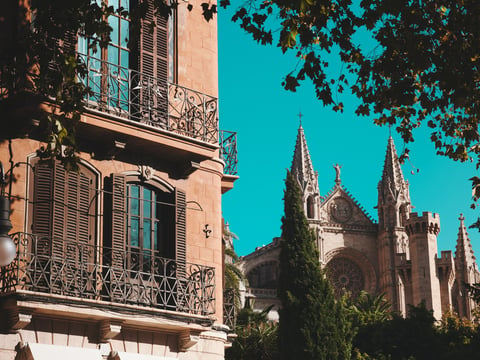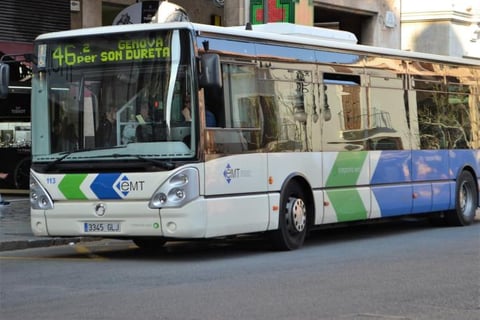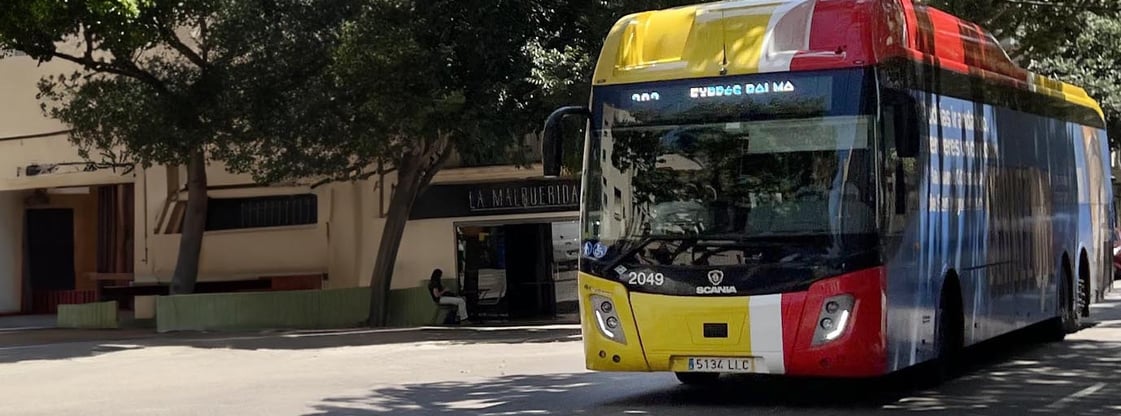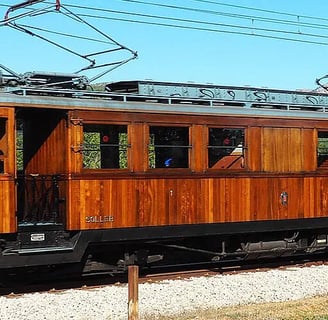Discover the vibrant city of Palma de Mallorca and learn how to navigate its picturesque streets and attractions without a car.
This guide offers tips for exploring Palma, including transport options and recommendations for a memorable stay
6 min read


Introduction
Palma de Mallorca, a gem in the Balearic Islands, beckons travelers with its stunning blend of ancient history, vibrant street life, and breathtaking Mediterranean scenery. Whether you're meandering through the winding alleys of the old town or soaking in the coastal views, Palma is a city that can easily capture your heart. In this article, we'll take you on a virtual tour of Palma, answering key questions about transportation and travel times to help you plan the perfect visit.
Can You Get Around Palma Without a Car?
Absolutely! Palma de Mallorca is wonderfully compact and pedestrian-friendly, making it a delight to explore on foot. The city's layout is conducive to walking, and many of its most famous attractions are located within a manageable distance from each other. For those who prefer not to walk, Palma offers a variety of other transportation options, which we will explore in the next sections.
Walking Tour of Palma's Must-Visit Spots


Begin your walking tour at La Seu, Palma's majestic cathedral. With its gothic architecture dramatically overlooking the sea, it’s a perfect starting point. Just a short stroll away, you can explore the Almudaina Palace, a royal residence with Islamic origins. As you continue, lose yourself in the quaint streets of the Old Town, dotted with hidden courtyards, local boutiques, and cozy cafes.
Walking north, you'll encounter the bustling Plaza Mayor, a great spot to experience Palma's lively street performances and grab a bite at one of the many terraces. Further exploration leads to the Passeig des Born, a broad, tree-lined avenue ideal for shopping and people-watching.
Alternative Transport Options in Palma
Mallorca boasts a dynamic public transport network, continuously updated to enhance connections between towns and meet the needs of its users.
Central to this network is Palma's Plaza de España, a vital hub for buses, trains, and the metro, with services radiating from this point.
Accessibility is a priority across the network, with vehicles and stations designed to meet universal accessibility standards.
Buses: The island offers two bus services: the metropolitan buses of Palma (EMT) and the intercity buses (TIB).
Metropolitan Buses (EMT Palma): Operating within Palma, these buses connect the city centre to various neighbourhoods and nearby towns, easily recognisable by their white, blue, and green livery. Most city bus routes converge at Plaza de España, simplifying transfers to intercity buses, trains, and the metro.
Tickets: Tickets can be purchased directly on the bus, where only cash up to 10 euros is accepted, or through a pre-paid card available at various sales points. Children under five travel free with a ticketed adult.
Tourist Routes:
Airport services include lines A1 to Palma city centre and A2 to s'Arenal.
Line 1 connects the port with the city centre.
Line 2 offers free travel around the city centre.
Lines 4, 25, and 35 serve popular beaches near Palma.
Line 46 heads to the Pilar i Joan Miró Foundation.
Line 50, the city sightseeing bus, explores multiple city routes.
Travelling with Pets: Dogs may travel on all lines, either in a transport basket or leashed and muzzled.
Intercity Buses (TIB): These buses, marked by their red and yellow colours, cover the entire island. The network is divided into five groups (100-500), spreading radially from Plaza de España to various Mallorcan regions, with certain routes serving Palma airport during summer.
Tickets: For intercity buses, trains, and the metro, tickets can be purchased using a bank card directly on the transport, or online in advance for a discounted price.
Travelling with Pets: Only guide dogs are permitted on intercity buses.
Travelling with Bicycles: Intercity buses are equipped with two bicycle racks.
Metro: Palma's metro line M1 links the city centre with the University campus (UIB), passing through several key areas.
Train: Palma features two train stations at Plaza de España: the historic Sóller station and the modern intermodal station with services to Inca (T1), sa Pobla (T2), and Manacor (T3).
Bicycles on Trains and Metro: Most trains accommodate bicycles in designated areas. Check the latest timetable for details.






Navigating Palma Mallorca for a Day
If you only have a day to spare in Palma, a strategic approach to transport can help you maximize your visit. Start early at the cathedral, then wander through the Old Town and visit the major sites before lunch. In the afternoon, consider a bus ride or a bike trip along the promenade to visit the Bellver Castle, offering panoramic views of the city from its unique circular structure.
How Many Days Are Enough for Palma?
To truly experience Palma de Mallorca, a stay of three to four days is ideal. This allows you sufficient time to delve into the city's rich history, enjoy its cultural offerings, relax at the beach, and even explore nearby attractions. Each day can be themed differently; dedicate one to historical sites, another to shopping and modern attractions, and another day for an excursion to nearby points of interest like the hill town of Valldemossa or the stunning nearby beaches.
Conclusion
Palma de Mallorca offers a delightful experience whether you choose to explore it on foot, by bike, or using public transport. With a well-planned itinerary, you can enjoy all the historical, cultural, and scenic pleasures this city has to offer in just a few days. Remember, the essence of Palma is best absorbed at a leisurely pace, with frequent stops to admire its beauty and to indulge in its culinary delights.
FAQs
What is the best time of year to visit Palma de Mallorca?
The best time to visit Palma de Mallorca is during the spring (April to June) and autumn (September to October). These periods offer pleasant weather, with temperatures ranging from 18°C to 25°C, which is ideal for exploring the city and enjoying the beaches. The summer months are hotter and more crowded, while winter is mild but quieter, which might appeal to those looking for a more relaxed visit.
Are there guided tours available in Palma?
Yes, Palma offers a variety of guided tours that cater to different interests. These include walking tours of the historic city center, bike tours, food and wine tours, as well as bus tours that take you around the main attractions. For a unique perspective, you can also find boat tours that show you the beauty of the city from the water.
What are some recommended local dishes to try in Palma?
Palma de Mallorca boasts a rich culinary scene that highlights local ingredients. Key dishes to try include:
Paella Mallorquina: a local take on the classic Spanish paella, often made with fresh seafood.
Tumbet: a delicious vegetarian dish made with layers of fried vegetables such as potatoes, aubergines, and red bell peppers, topped with tomato sauce.
Ensaimada: a sweet, fluffy pastry that is perfect for breakfast or a snack.
Sobrassada: a soft, spreadable sausage made from pork and paprika, unique to the Balearic Islands.
Is Palma suitable for family travel?
Absolutely! Palma is very family-friendly, offering a wide range of activities that appeal to all ages. From the beautiful beaches and parks to interactive museums like the Palma Aquarium, there's plenty to keep children entertained. The city is also safe and easy to navigate, making it convenient for families to explore.
How should I dress when visiting religious sites in Palma?
When visiting religious sites such as the Palma Cathedral, it's important to dress modestly. This generally means avoiding sleeveless tops and shorts. Knee-length skirts or trousers and shirts that cover the shoulders are recommended. Many religious sites provide shawls or cover-ups for visitors who may not be aware of the dress code.
What are the best areas to stay in Palma?
Choosing where to stay in Palma depends on what you want from your visit:
Old Town (Casco Antiguo): Ideal for those interested in history and culture. Staying here means you're close to major landmarks and the charming narrow streets of the city center.
Santa Catalina: A trendy area known for its vibrant nightlife and culinary scene, perfect for foodies and night owls.
Paseo Maritimo: Offers scenic views of the marina and is well-positioned for those looking to explore both the city and the sea.
Playa de Palma: Best for beach lovers and families looking for a beach resort atmosphere with easy access to the city’s attractions.
